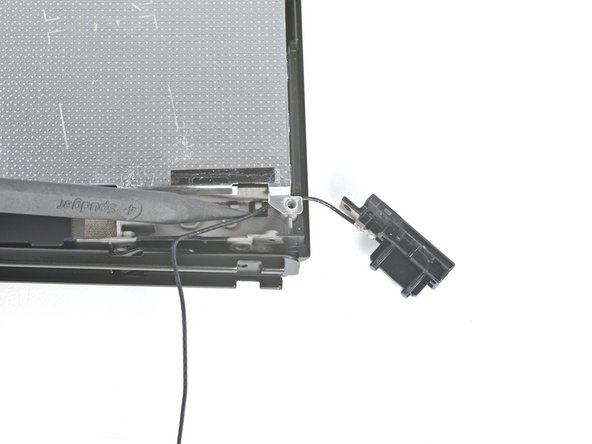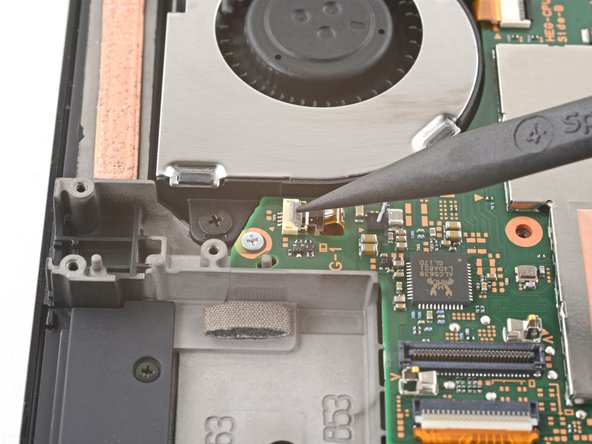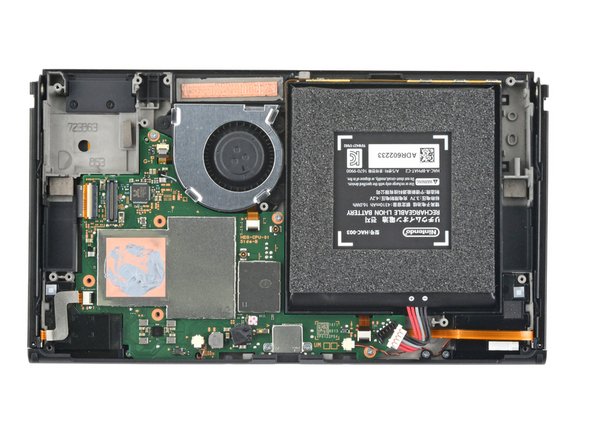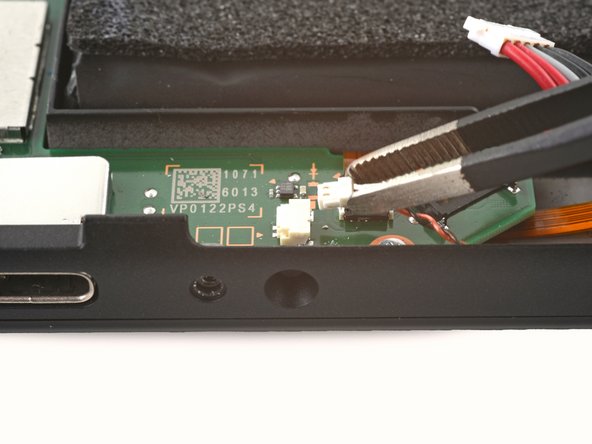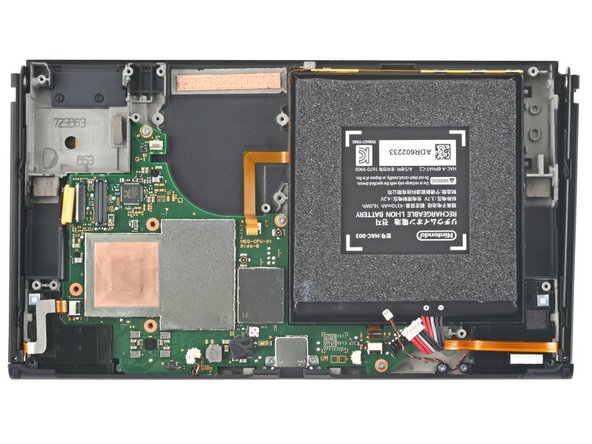How to Replace Nintendo Switch OLED Bottom Rail Guide
Duration: 45 minutes
Steps: 48 Steps
Keep things cool! Make sure your Switch’s battery is below 25% before diving into disassembly.
Get ready to swap out the bottom rail of your Nintendo Switch OLED! Before diving in, make sure to keep safety first by discharging that battery below 25%. This little step helps prevent any fiery surprises if the battery gets a bit too adventurous during the repair. If your battery looks like it’s been through a balloon party, take the necessary precautions. The Switch OLED loves JIS screws, but if you find yourself in a pinch, a Phillips screwdriver will do the trick—just be gentle and avoid stripping those screws! Our Phillips bits are designed to work well with JIS-style screws, so you’re covered. Oh, and when you take off the shield plate, don’t forget to replace the thermal compound between the plate and the heatsink. Regular thermal paste isn’t quite up to the task of bridging those gaps, so grab some K5 Pro viscous thermal paste instead. And remember, you’ll need standard thermal paste when swapping out the heatsink. If you hit a snag, don’t hesitate to schedule a repair!
Step 1
Before diving into this repair adventure, let’s make sure your device is fully powered down. Safety first, right?
– Find the small round button on the back of the Joy Con controller and give it a confident press and hold.
– While holding down that button, smoothly slide the controller upward like a pro.
Step 2
Now, let’s go ahead and give the other Joy Con some love by repeating these same steps! You’ve got this!
– Keep sliding the Joy-Con upward with a smooth motion until it pops off like magic and is fully detached from the console. Easy peasy!
Step 3
To keep those pesky screws from getting stripped, press down firmly, take your time, and if they’re being stubborn, give a different JIS or Phillips driver a shot!
– Grab your trusty Phillips or JIS driver and get ready to tackle that 2 mm-long screw holding the top of the rear case to the frame. You’ve got this!
Step 4
– Grab your trusty Phillips driver and unscrew those two 2 mm screws holding the bottom of the rear case to the frame—easy peasy!
Step 5
To keep those tight screws from becoming a hassle, press down firmly, take it slow, and if they’re still stubborn, try a different JIS 000 or PH 000 driver.
– Grab your trusty Phillips driver and let’s get that 3.8 mm screw out of the way! It’s holding the right Joy-Con sensor rail to the rear case, and we need to free it up. You’ve got this!
Step 6
– Grab your trusty Phillips driver and get ready to tackle that 3.8 mm screw holding the left Joy-Con sensor rail snugly to the rear case. Let’s get this party started!
Step 7
Hey there! Before you dive into the next step, let’s make sure to pop out that microSD card from its slot if there’s one hanging out. It’s a small but mighty step that’ll keep things smooth sailing from here on out!
– Give the kickstand a little nudge with your finger to pop it up from the back of the device—easy peasy!
Step 8
– Let’s get started by using a Y00 screwdriver to remove the two 4.3 mm screws that hold the rear case in place. Simply unscrew them and set them aside – you’ll need them later!
Step 9
Struggling to pop off the case? Grab an opening pick and gently nudge those plastic clips loose—it’s easier than it sounds, promise!
– Gently lift the back cover off from the top edge of the device and set it aside—look at you, making progress like a pro!
Step 10
– Grab the flat end of your trusty spudger and gently pry up a corner of the tape from the shield plate. You’ve got this!
Tools Used
Step 11
– Grab your tweezers or just use your fingers, and gently peel back the tape.
– Keep the tape in a clean spot so it’s ready for reinstallation.
Tools Used
Step 12
– Grab some tweezers or just use your fingers to gently lift and disconnect the main Wi-Fi antenna’s coaxial cable. You’ve got this!
– Reconnecting these little guys during reassembly can be a bit of a puzzle. Take it slow—hold each connector above its socket and give it a gentle press with the flat end of your spudger. You’ll hear a satisfying snap when it clicks into place!
Step 13
– Grab those tweezers or just use your fingers to gently guide the primary antenna’s coaxial cable out of its cozy little slots in the shield plate. You’ve got this!
Tools Used
Step 14
– Grab your trusty Phillips driver and take out the two 4.4 mm screws holding the main Wi-Fi antenna to the shield plate. Easy peasy, you’re doing awesome!
Step 15
– Slide an opening pick gently between the main Wi-Fi antenna and the shield plate—it’s like separating two best friends at a party.
– Give it a little lift with the pick to detach the primary Wi-Fi antenna from its buddy, the shield plate. Take your time, no rush!
Step 16
– Take out the main Wi-Fi antenna with care.
Step 17
– Time to get a little cozy with your device’s insides! Use tweezers or your fingers to gently pull up and disconnect the secondary Wi-Fi antenna’s coaxial cable. Nice and easy, you’ve got this!
Tools Used
Step 18
– Take a spudger and carefully reroute the secondary Wi-Fi antenna’s coaxial cable from its spot in the frame. You’ve got this!
Tools Used
Step 19
– Grab a Phillips driver and unscrew the 4.4 mm screw holding the secondary Wi-Fi antenna to the shield plate—you’re doing great!
Step 20
Hold up! Don’t yank that antenna out just yet—its coaxial cable is still snaking through the frame.
– Slide an opening pick between the secondary Wi-Fi antenna and the shield plate.
– Gently lift the pick to separate the secondary Wi-Fi antenna from the shield plate.
Step 21
– Grab your trusty spudger and gently pop the secondary Wi-Fi antenna’s coaxial cable out of its snug little spot in the frame. Easy does it!
– Carefully take out the secondary Wi-Fi antenna. You’re doing great!
Tools Used
Step 22
– Grab your trusty Phillips driver and unscrew the six 4.4 mm screws holding the shield plate snugly to the frame. Easy does it!
Step 23
You might notice a little pushback—totally normal! The shield plate is snugly stuck to the heat sink thanks to some thermal paste magic.
– Gently lift the top of the shield plate using your fingers, pulling it away from the frame like you’re opening a tiny treasure chest.
– Take out the shield plate and set it aside.
– You’ll notice a thick pink thermal paste connecting the shield plate and the copper heat sink underneath. Whenever you pop off the shield plate, check out our thermal paste guide to clean off the old compound and swap in a fresh layer of an appropriate paste, like K5 Pro, when putting everything back together.
Step 25
– Gently grab the tape covering the daughterboard screw with tweezers or your fingers and peel it off. Careful not to rip it too much—this tape’s just doing its job!
Tools Used
Step 26
– Grab your trusty Phillips driver and let’s tackle this! Remove that 4 mm screw that’s holding the daughterboard snugly to the frame. You’ve got this!
Step 27
The underside of the daughterboard is snugly connected to the motherboard using a press connector. Keep it cool and steady as you work your magic!
– Gently slide a spudger between the edge of the daughterboard and the motherboard. Be careful not to rush this part.
– Use the spudger to carefully pry up, disconnecting the press connector, and freeing the daughterboard from the frame.
– Now, gently remove the daughterboard.
– When reattaching press connectors like this one, line it up carefully, then press down on one side until you hear a satisfying click. Do the same on the other side. Avoid pressing the middle—this could lead to misalignment and bent pins, which could cause permanent damage.
Tools Used
Step 28
– Grab your trusty Phillips driver and remove the three 3mm screws holding down the heat sink to the motherboard. You’ve got this!
Step 29
You might feel a little resistance. It’s totally normal—the heat sink is just a bit stuck to the CPU with thermal paste.
– Gently wedge your trusty spudger between the heat sink’s bracket and the motherboard. Take your time—there’s no rush!
– Use the spudger to carefully lift the heat sink away from the motherboard. It’s all about finesse, not force!
Tools Used
Step 30
– Time to get this repair started! Insert a spudger into the gap between the fan and the heat sink – it’s like the key to unlocking the whole process.
– Now, gently pry up with the spudger to separate the heat sink from the adhesive beneath it. Be patient and careful, we’re making progress!
– The heat sink is now ready to come off – simply remove it and set it aside for now.
– It’s cleaning time! Use some high-concentration (90% or higher) isopropyl alcohol and a microfiber cloth to wipe away the old thermal paste from the heat sink and CPU. Then, apply new thermal paste to the CPU before we start reassembling everything. You’re doing great!
Tools Used
Step 31
– Gently use the tip of a spudger, an opening tool, or even your trusty fingernail to lift up that little hinged locking flap on the fan cable’s ZIF connector. You’ve got this!
Tools Used
Step 32
– Grab your trusty tweezers and gently tug the fan cable straight out of its cozy connector on the motherboard. You’ve got this!
Tools Used
Step 33
– Grab your trusty Phillips driver and unscrew those three 3 mm screws holding the fan snugly to the frame. You’ve got this!
Step 34
– Grab your trusty spudger and gently lift the fan straight out of the frame. You’ve got this!
– Now, go ahead and remove the fan. Easy peasy!
Tools Used
Step 35
– Grab your trusty opening tool, spudger, or even your fingernail, and gently lift that little hinged locking flap on the power button board’s ZIF connector. You’ve got this!
Tools Used
Step 36
– Grab a trusty pair of tweezers and gently wiggle the power button board cable free from its cozy connector on the motherboard. You’ve got this!
Tools Used
Step 37
– Grab your trusty opening tool, spudger, or even your fingernail and gently lift that little hinged locking flap on the right Joy-Con sensor rail’s ZIF connector. You got this!
Tools Used
Step 38
– Grab a trusty pair of tweezers and gently pull the right Joy-Con sensor rail’s cable straight out of its connector on the motherboard. You’ve got this!
Tools Used
Step 39
– Grab your trusty opening tool, spudger, or even your fingernail, and gently pop up the hinged locking flap on the display’s ZIF connector. Easy does it—you’re doing great!
Tools Used
Step 40
– Grab those trusty tweezers and pull the display cable straight out of its cozy connector on the motherboard.
Tools Used
Step 41
– Grab some blunt tweezers, or just use your fingers, and gently unplug the left speaker’s JST connector from its socket. You got this!
Tools Used
Step 42
– Grab some blunt tweezers or your trusty fingers, and gently wiggle the right speaker’s JST connector out of its cozy little socket. Easy does it!
Tools Used
Step 43
– Grab your trusty opening tool, spudger, or even your fingernail, and gently lift that little hinged locking flap on the right Joy-Con sensor rail’s ZIF connector. You’ve got this!
Tools Used
Step 44
– Grab a pair of tweezers and gently pull the left Joy-Con sensor rail’s cable straight out from its connector on the motherboard. Take your time, it’s a delicate move!
Tools Used
Step 45
– Grab your trusty Phillips screwdriver and take out the five screws holding the midframe to the frame:
– Three little 3 mm screws
– Two slightly bigger 4.4 mm screws
Step 46
– Time to get this repair started! Carefully insert a spudger between the motherboard and the frame to begin the separation process.
– Now, gently pry up with the spudger to loosen the motherboard from the frame – it’s like freeing a stuck part!
– The final step in this section: remove the motherboard, and you’re one step closer to a fully repaired device!
Tools Used
Step 47
– Grab your trusty Phillips driver and pop out those two 3mm screws holding the bottom rail to the frame.
Step 48
– Take off the bottom rail like a pro! It’s time to get that part out of the way so we can dive into the good stuff.
Success!



















































